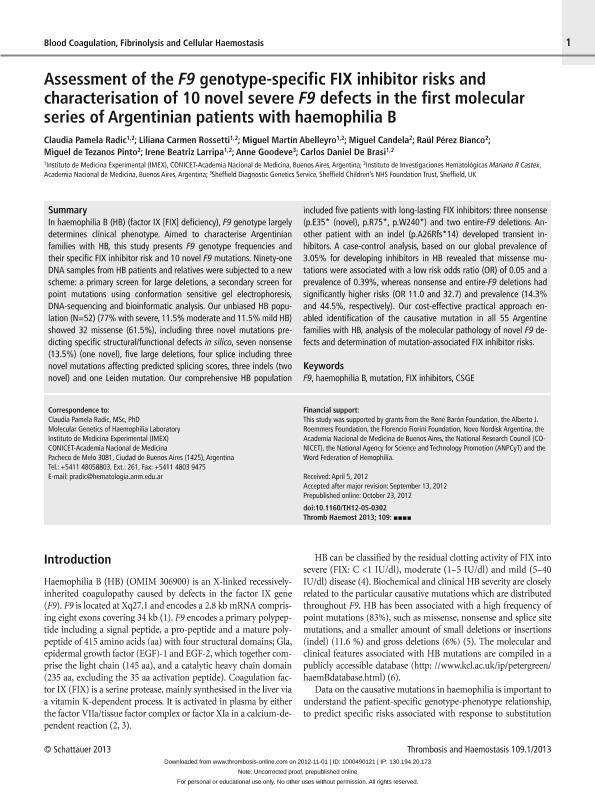Artículo
Assessment of the F9 genotype-specific FIX inhibitor risks and characterization of 10 novel severe F9 defects in the first molecular series of Argentine patients with haemophilia B
Radic, Claudia Pamela ; Rossetti, Liliana Carmen
; Rossetti, Liliana Carmen ; Abelleyro, Miguel Martin
; Abelleyro, Miguel Martin ; Candela, Miguel; Pérez Bianco, Raúl; de Tezanos Pinto, Miguel; Larripa, Irene Beatriz
; Candela, Miguel; Pérez Bianco, Raúl; de Tezanos Pinto, Miguel; Larripa, Irene Beatriz ; Goodeve, Anne; de Brasi, Carlos Daniel
; Goodeve, Anne; de Brasi, Carlos Daniel
 ; Rossetti, Liliana Carmen
; Rossetti, Liliana Carmen ; Abelleyro, Miguel Martin
; Abelleyro, Miguel Martin ; Candela, Miguel; Pérez Bianco, Raúl; de Tezanos Pinto, Miguel; Larripa, Irene Beatriz
; Candela, Miguel; Pérez Bianco, Raúl; de Tezanos Pinto, Miguel; Larripa, Irene Beatriz ; Goodeve, Anne; de Brasi, Carlos Daniel
; Goodeve, Anne; de Brasi, Carlos Daniel
Fecha de publicación:
01/2013
Editorial:
Schattauer Gmbh-Verlag Medizin Naturwissenschaften
Revista:
Thrombosis and Haemostasis
ISSN:
0340-6245
Idioma:
Inglés
Tipo de recurso:
Artículo publicado
Clasificación temática:
Resumen
In haemophilia B (HB) (factor IX [FIX] deficiency), F9 genotype largely determines clinical phenotype. Aimed to characterise Argentinian families with HB, this study presents F9 genotype frequencies and their specific FIX inhibitor risk and 10 novel F9 mutations. Ninety-one DNA samples from HB patients and relatives were subjected to a new scheme: a primary screen for large deletions, a secondary screen for point mutations using conformation sensitive gel electrophoresis, DNA-sequencing and bioinformatic analysis. Our unbiased HB population (N=52) (77% with severe, 11.5% moderate and 11.5% mild HB) showed 32 missense (61.5%), including three novel mutations predicting specific structural/functional defects in silico, seven nonsense (13.5%) (one novel), five large deletions, four splice including three novel mutations affecting predicted splicing scores, three indels (two novel) and one Leiden mutation. Our comprehensive HB population included five patients with long-lasting FIX inhibitors: three nonsense (p.E35* (novel), p.R75*, p.W240*) and two entire-F9 deletions. Another patient with an indel (p.A26Rfs*14) developed transient inhibitors. A case-control analysis, based on our global prevalence of 3.05% for developing inhibitors in HB revealed that missense mutations were associated with a low risk odds ratio (OR) of 0.05 and a prevalence of 0.39%, whereas nonsense and entire-F9 deletions had significantly higher risks (OR 11.0 and 32.7) and prevalence (14.3% and 44.5%, respectively). Our cost-effective practical approach enabled identification of the causative mutation in all 55 Argentine families with HB, analysis of the molecular pathology of novel F9 defects and determination of mutation-associated FIX inhibitor risks
Palabras clave:
Csge
,
F9
,
Fix Inhibitors
,
Haemophilia B
,
Mutation
Archivos asociados
Licencia
Identificadores
Colecciones
Articulos(IMEX)
Articulos de INST.DE MEDICINA EXPERIMENTAL
Articulos de INST.DE MEDICINA EXPERIMENTAL
Citación
Radic, Claudia Pamela; Rossetti, Liliana Carmen; Abelleyro, Miguel Martin; Candela, Miguel; Pérez Bianco, Raúl; et al.; Assessment of the F9 genotype-specific FIX inhibitor risks and characterization of 10 novel severe F9 defects in the first molecular series of Argentine patients with haemophilia B; Schattauer Gmbh-Verlag Medizin Naturwissenschaften; Thrombosis and Haemostasis; 109; 1; 1-2013; 24-33
Compartir
Altmétricas



